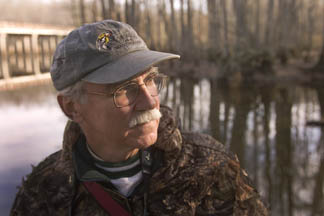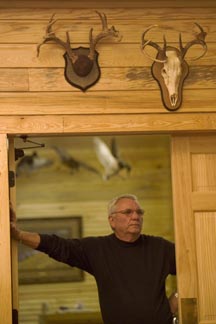Elusive bird is everywhere and nowhere
By Krishna Ramanujan

BRINKLEY, Ark. - As Cornell's Lab of Ornithology staffers and volunteers gear up for a six-month search for the ivory-billed woodpecker, residents of Brinkley might be wondering why this bird is so hard to find.
"Everybody I know in Brinkley has said they've seen the bird," said Butch Turner, manager of the Mallard Pointe Lodge and Reserve, a hunting lodge just outside of town. "Two of our guys [lodge employees] say they've seen the bird, and these are guys who have lived all their lives around the Big Woods."
Still, nobody seems able to point a camera and get a clear image of the elusive woodpecker.
Unlike the townspeople, who say the bird is ubiquitous, Ron Rohrbaugh, director of the lab's Ivory-billed Woodpecker Research Project, says the possibility exists that they may be searching for only one or two woodpeckers in an area of bottomland forest three-quarters the size of Rhode Island.

This year marks one of the worst droughts in local memory, with water levels between seven and 15 feet lower than normal in the Bayou DeView, for example, making canoeing in many areas impossible. Remaining water sits black-brown like glassy mud, dimmed by the dense growth of cypress and tupelo trees with their wide, water-logged root buttresses that narrow like wine bottles to the trunks.
To find a roost or a nest to which these nomadic birds might repeatedly return - providing undisputable proof for skeptics, as well as boundless opportunity for in-depth study - the search team uses global positioning system (GPS) units to methodically transect and map their surveys for large, oval tree cavities characteristic of ivory-bills.
Only six or so such likely cavities have been found to date, on which team members have trained time-lapse video cameras to hopefully record the birds arriving or leaving a roost at dawn and dusk. The searchers have also aimed motion- and heat-triggered still-life game cameras on places of interest.
As with last year's search, technicians also have placed automated recording units in key woodpecker habitats, with hopes of recording the woodpecker's nasal toot or its characteristic double knock.
Volunteers work 12-hour days, from 6 a.m. to 6 p.m., alternating between paddling up and down stretches of bayou and sitting for hours on end in hidden blinds or platforms with eyes glued to the sky. Each carries binoculars, a video camera and a GPS unit. Whenever something moves, volunteer Sam Stuart of Phoenixville, Pa., says he grabs his video camera and starts shooting.
"It's hard," he says. "There is very little open space between you and the next stand of trees."
Similarly, Mia Revels, a volunteer from Tahlequah, Okla., describes seeing a woodpecker land in a tree. "You pick up your binoculars, but then it's just a pileated [woodpecker] - but your heart starts racing."
Media Contact
Get Cornell news delivered right to your inbox.
Subscribe